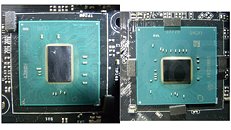Raevenlord
News Editor
- Joined
- Aug 12, 2016
- Messages
- 3,755 (1.18/day)
- Location
- Portugal
| System Name | The Ryzening |
|---|---|
| Processor | AMD Ryzen 9 5900X |
| Motherboard | MSI X570 MAG TOMAHAWK |
| Cooling | Lian Li Galahad 360mm AIO |
| Memory | 32 GB G.Skill Trident Z F4-3733 (4x 8 GB) |
| Video Card(s) | Gigabyte RTX 3070 Ti |
| Storage | Boot: Transcend MTE220S 2TB, Kintson A2000 1TB, Seagate Firewolf Pro 14 TB |
| Display(s) | Acer Nitro VG270UP (1440p 144 Hz IPS) |
| Case | Lian Li O11DX Dynamic White |
| Audio Device(s) | iFi Audio Zen DAC |
| Power Supply | Seasonic Focus+ 750 W |
| Mouse | Cooler Master Masterkeys Lite L |
| Keyboard | Cooler Master Masterkeys Lite L |
| Software | Windows 10 x64 |
Things seem to be taking turns to the worse at Intel in accordance to Murphy's law. Not only was the company hit with a multitude of security flaws embedded in their CPUs, which puts their michroarchitecture design chops in jeopardy, but now they also have to contend with silicon fabrication snags. That Intel's 14 nm fabs are being hit with overwhelming demand for their output capacity is already a known quantity, with rising prices of Intel mainstream CPUs and reports of the company outsourcing 14 nm chip production to TSMC in a bid to increase availability - a first since the company became vertically integrated with both design and manufacturing of their own chips.

Now, reports are coming up that Intel will be moving some of its chipsets back to the 22 nm node - namely, the H310 chipset - so as to clear production capability from the 14 nm one. As you might remember, historically, Intel's chipsets have been one silicon manufacturing generation behind their CPUs. Due to the problems in Intel's 10 nm process and constrained output of their 14 nm process, this has now become a necessity again. The new H310 chipset, which had to be architecturally revised for 22 nm (which isn't as easy a thing as one might expect) will debut in the H310C or H310 R2.0 indicator. It will be physically larger (naturally) and incur in a small power efficiency loss as well, and - get this - support Windows 7, likely via asoftware/driver solution. Motherboards with the new chipset are already moving out into the supply chain.
View at TechPowerUp Main Site

Now, reports are coming up that Intel will be moving some of its chipsets back to the 22 nm node - namely, the H310 chipset - so as to clear production capability from the 14 nm one. As you might remember, historically, Intel's chipsets have been one silicon manufacturing generation behind their CPUs. Due to the problems in Intel's 10 nm process and constrained output of their 14 nm process, this has now become a necessity again. The new H310 chipset, which had to be architecturally revised for 22 nm (which isn't as easy a thing as one might expect) will debut in the H310C or H310 R2.0 indicator. It will be physically larger (naturally) and incur in a small power efficiency loss as well, and - get this - support Windows 7, likely via asoftware/driver solution. Motherboards with the new chipset are already moving out into the supply chain.
View at TechPowerUp Main Site







